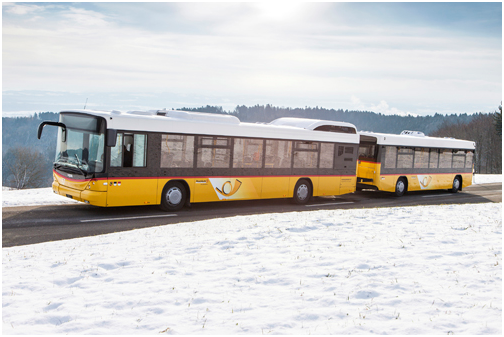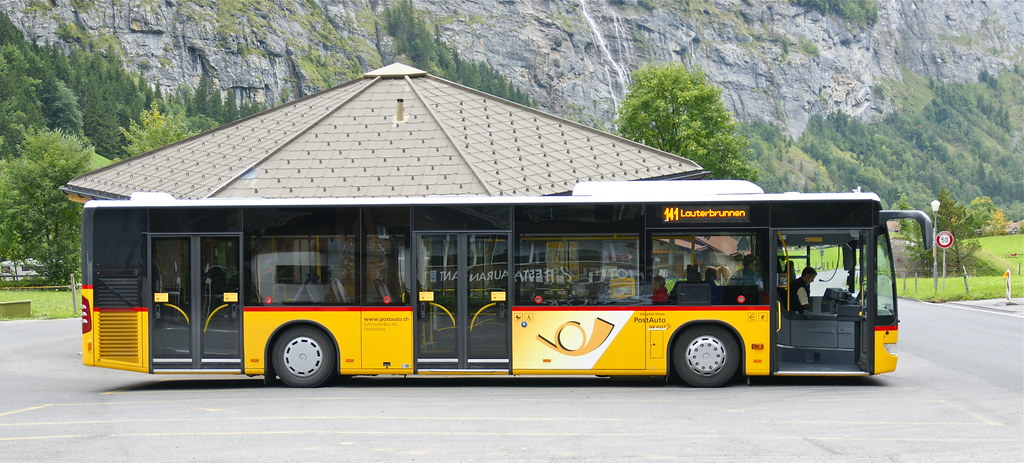PostBus Switzerland
As Postbus successor motorized stagecoach are referred to primarily in Switzerland. In other countries the term Postbus is in use.
Used to be the combination of postal and passenger transportation usual, these needs could vote getting worse each other, so that the mail transport were largely isolated from public transport towards the end of the twentieth century. This was true not only for the postal cars, but also for other franchised bus routes and also for the railroad. Already a little earlier and the express and general cargo transport from the public transport system has been solved. This separation showed up eventually in the legal form of the post bus Switzerland AG as a 100 percent subsidiary of Swiss Post. As before, in peripheral regions post offices will be supplied by post buses with mail.
- 5.1 Liechtenstein
- 5.2 France
The Company
- Market West with the regions Bern, North Switzerland, Valais, Switzerland and West
- East market with the regions Graubünden, Graubünden, Ticino, Central Switzerland, Zurich and the Post Bus Liechtenstein Anstalt
- International Market comprising 10 subsidiaries in France
- Finances
- Logistics
- Communication
- Marketing and Strategy
- Staff
The Swiss business the Group unit, which is also responsible for the management of the companies in France and the Principality of Liechtenstein running since February 2005 under its own legal personality as a post- car Switzerland AG, with headquarters in Bern.
Postbus operates as a licensed transport companies in Switzerland currently 814 postal routes with 2157 postal cars. Around 130 million passengers annually transported on the route network of 11'249 km. The lines are the so-called post car company operated either by its own staff Postbus Switzerland AG (Regiebetriebe ) or by some 200 contractors of post bus with its own personnel. The Postbus Switzerland AG employs around 1560 people ( administrative staff and crew ) who are employed by private law collective bargaining agreement. In the post- car company around 1520 chauffeurs are hired.
Postbus offers comprehensive services in the public, semi-public and private passenger:
- PubliCar: Rufbussystem for sparsely populated areas
- ScolaCar: minibuses for school transport
- Travel and Leisure: private travel ( holiday packages and charter flights)
Postbus takes as system leader in public bus performs various system services. This includes, for example, the operation of IT-based sales systems for several businesses within a collective network.
- PubliBike: 's largest bike-sharing companies in Switzerland with more than 100 stations
Transportation rights, compensation
Originally the post rack also included the regular and commercial passenger transport on the road. The post office could afford to set up their own account by bus concessions to other companies. This law took the covenant later, and in 1999 the passenger shelf was generally transmitted to the Federation. Since then, the post office or post car itself needs a passenger transport license. It is also possible to write out lines in the competition and to transfer the license and the contract to another company. Postbus is that public transport companies, which was in Switzerland previously exposed to tender competition the most. Far post car could hold its own in competition and won the majority of the calls. Examples are the lines in Interlaken, Entlebuch, Spiez, Laupen. There were also calls that are not won postal car, such as the lines in Sarganserland or those in the Upper Engadine.
By 1995, deficits of the then post bus service were (now Swiss Post and Swisscom) financed with the proceeds of the telecommunications sector of the former PTT, whereas the other bus transport companies and the so-called private railways by the cantons. 1996 has been harmonized modes of transport with the revision of the Railway Act, the public transport funding. It was then on the order principle according to which all companies in the regional public transport (Bus, other bus companies, trains, boats, cable cars ) services to its buyers had to offer in advance ( Confederation and cantons). Since then, the lines of regional transport are appointed jointly by the Confederation and the cantons and paid the offered uncovered costs. The co-financing by the federal government is subject to certain conditions, such as a segment accounting must be performed. The tenders that the transport companies are to submit the cantons as the lead customer binding. A subsequent deficit coverage is excluded. Thus, the transport companies have the risk to enter losses, but can also generate profits. Postbus 2011 writes the 13th consecutive year in the black.
Cooperation in public transport
Postal routes are part of the system of "public transport" in Switzerland. They supply alpine valleys, areas without railway connection and tourist destinations, but also drive in urban transport and urban (eg Brig, Martigny, Interlaken, Moutier, as well as a transport officer in Sion, Dels mountain and Bellinzona ). Postal routes operate mostly a train station, to ensure the connection to the railway network or they are linked to other bus routes. The timetables of bus routes are generally coordinated in Switzerland in order and schedule processes on the schedules of the trains. As far as possible, is run like clockwork. The number of trips per line depends on the demand, as a rule, at least four currency pairs per day. In the urban areas of the half -hour or quarter hour applies.
Post car is involved in the so-called direct traffic in the national tariff association. Here, a ticket for a trip across lines of different businesses and also different modes of transport are purchased. In addition, the half-fare card and the general ticket apply. On lines of tourist traffic, which do not operate year-round or have no tapping function for permanently inhabited villages, the public sector does not pay any compensation to the unmet costs. All of the public transport tickets are valid but also on this post bus lines. In the flat - travel tickets (eg the general ticket for public transport ) but surcharges are levied. The corresponding line segments are marked in timetables especially. Where regional tariff networks exist, the corresponding rates are also on the post bus lines.
History
The first post wrong car on June 1, 1906 by Bern to Detligen. 1919 followed on the Simplon rides over the mountain passes. The Swiss Travel Post, as the postal bus service was called up to the 1990s, gradually replaced the horses posts by postal cars, but opened up thanks to the monopoly (post shelf, see above), numerous new areas.
The postal, telephone and telegraph companies (PTT ) held a portion of the vehicles themselves These buses wore like all the post cars belonging license plates bearing the words "P" instead of the usual canton abbreviation. The majority awarded the PTT the transport request private bus companies, the postal car owners. This policy is maintained today. The mail cars had mostly a gate at the rear, so that the cargo of the post could be a loaded and unloaded easily. They were mostly Swiss brands of Saurer, Berna and FBW. There were also similar buses from Mercedes and Volvo. They were superseded in the 1990s, coverage of more modern buses.
Features
A coach is characterized by its yellow color. The detailed design of the paint and markings varied over the decades. Currently it consists of yellow vehicle hull, red, circular line on the lower window edge, white roof and a large, stylized post horn on the side surfaces.
Stark is brought by Postbus also associated the characteristic three-tone horn, whose melody comes from the Andante of the overture to Rossini's William Tell and the sounds cis -ea in A Major covers. The three-tone horn is used in regular service on mountain postal routes for signaling or warning, for example, before blind corners; buses other licensed companies are allowed to use it for this purpose. In the three-tone horn the tradition of post-horn lives on. The postal cars and other buses on mountain roads are next to Post police and rescue vehicles, the single motor vehicles in Switzerland, are approved for multi-tone horns.
With the slump in new markets, such as the operation of local buses, there were also post car in other colors. A new development took place when the Canton of Aargau from all bus and narrow gauge railway companies demanded their vehicles to miss a uniform white appearance with black, red and blue stripes to document belonging to the tariff A-Welle. However, this new color concept sparked outrage among many Aargauern.
Fleet
For new buses air conditioning, visual and audible passenger information and free WiFi are considered standard. The car park was and is continuously renewed. The range of vehicles ranging from minibuses (for example, Fiat Ducato, Mercedes Sprinter ) on low-floor buses (for example, Mercedes Citaro, Setra 315NF ), intercity buses (for example, Volvo 8700, Setra 313UL ) to two-story buses ( Neoplan N 4026/3, N 4426/3 ). As part of the project CHIC (Clean Hydrogen In European Cities ) since December 2011 in Brugg, Aargau Canton, five fuel cell postal cars in use.
Previously sat Postbus numerous buses from a Swiss production. This came from FBW and Saurer, after the merger of FBW and Saurer in 1982 by the commercial vehicle Arbon & Wetzikon ( NAW ), later NAW Commercial Vehicles Ltd, and are occasionally still in use. The bus structures often came from bodybuilding firms, for example, body shop Hess.
The charter also buses ( coaches) are used; these operate mainly under the name PostCar and can be distinguished from the line of vehicles through an image of a Gotthard post coach on the side walls, which are adorned with a post horn.
All buses, including those which are operated by the post office car companies are procured through the mail car Switzerland AG. The procurement of the different use types (eg bus stehplatz optimized suburban seating optimized articulated ) will be awarded in accordance with WTO rules in the two -year cycle. The Postbus AG Switzerland procured as per year between 80 and 120 vehicles.
Activities abroad
Liechtenstein
By the State Treaty between Switzerland and Liechtenstein, among other things, the postal service had been transferred to Switzerland. Thus, the former PTT was up to the expiry of the contracts in 2001 in the Principality of working. The operational business operated a Postautohalter.
Since June 1, 2001, manages the " Postbus Liechtenstein Anstalt " public transport in Liechtenstein as transport commissioner of traffic operations Liechtenstein mobile. Here, the buses in a green - yellow livery with the logo of " Liechtenstein Bus". The Swiss general ticket as well as tickets will be the Regional Transport Network Vorarlberg recognized on all Liechtenstein bus lines.
France
In France, the subsidiary of postal car, CarPostal France operates in the cities Dole, Obernai, Bourg -en- Bresse and Haguenau a bus network. In Dole CarPostal France are represented since January 1, 2004, the other towns followed in 2005 and 2006. In Lons- le -Saunier CarPostal France since 2006 makes technical assistance, but does not operate a bus network. In 2009, other networks were added ( Macon, Isère, Agde, Narbonne, Villefranche ).
Trivia
For the film Hors season of the Grisons filmmaker Daniel Schmid, a currently current line mail car was brought to the location by Portugal to the arrival of Valentine in the vacant Grand hotel of its day- to present the film in early 1991. It may well have been the farthest from the Swiss border station of a not yet retired postal cars. The scene is not seen in the trailer.
In the St. Gallen Festival 2010 Post car was used on the operatic stage; Car of the Alpine from the Saurer Museum, type S4C continues to the beginning of Donizetti 's opera Il Diluvio Universale front of the audience back on its stand and brings equal to the Maestro with. Then the utensils of the Noah family are stowed in it. In the second act the post bus runs with Noah's family from the stage.










